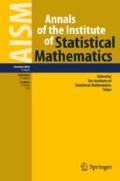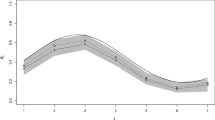Abstract
The distributions of the mth longest runs of multivariate random sequences are considered. For random sequences made up of k kinds of letters, the lengths of the runs are sorted in two ways to give two definitions of run length ordering. In one definition, the lengths of the runs are sorted separately for each letter type. In the second definition, the lengths of all the runs are sorted together. Exact formulas are developed for the distributions of the mth longest runs for both definitions. The derivations are based on a two-step method that is applicable to various other runs-related distributions, such as joint distributions of several letter types and multiple run lengths of a single letter type.

Similar content being viewed by others
References
Balakrishnan, N., Koutras, M. V. (2002). Runs and scans with applications. New York: Wiley.
Bradley, J. V. (1968). Distribution-free statistical tests. Englewood Cliffs: Prentice-Hall.
Burr, E. J., Cane, G. (1961). Longest run of consecutive observations having a specified attribute. Biometrika, 48, 461–465.
Eryilmaz, S. (2006). Some results associated with the longest run statistic in a sequence of Markov dependent trials. Applied Mathematics and Computation, 175, 119–130.
Fu, J. C., Wang, L., Lou, W. Y. W. (2003). On exact and large deviation approximation for the distribution of the longest run in a sequence of two-state Markov dependent trials. Journal of Applied Probability, 40, 346–360.
Glaz, J., Naus, J., Wallenstein, S. (2001). Scan statistics. New York: Springer.
Godbole, A. P., Papastavridis, S. G. (Eds.). (1994). Runs and patterns in probability: selected papers. Dordrecht: Kluwer Academic Publishers.
Knuth, D. E. (1997). The art of computer programming. Seminumerical Algorithms (3rd edn, vol. 2). Boston: Addison-Wesley Longman Publishing Co. Inc.
Kong, Y. (2006). Distribution of runs and longest runs: a new generating function approach. Journal of the American Statistical Association, 101, 1253–1263.
Kong, Y. (2015a). Distributions of runs revisited. Communications in Statistics Theory and Methods, 44, 4663–4678.
Kong, Y. (2015b). Number of appearances of events in random sequences: a new approach to non-overlapping runs. Communications in Statistics Theory and Methods (to appear).
Kong, Y. (2015c). Number of appearances of events in random sequences: a new generating function to Type II and Type III runs. Annals of the Institute of Statistical Mathematics. doi:10.1007/s10463-015-0549-2.
Koutras, M. V., Alexandrou, V. A. (1995). Runs, scans and urn model distributions: A unified Markov chain approach. Annals of the Institute of Statistical Mathematics, 47(4), 743–766.
Koutras, M. V., Papastavridis, S. G. (1993). On the number of runs and related statistics. Statistica Sinica, 3, 277–294.
Lou, W. Y. W. (1996). On runs and longest run tests: a method of finite Markov chain imbedding. Journal of the American Statistical Association, 91, 1595–1601.
Makri, F. S., Philippou, A. N., Psillakis, Z. M. (2007). Shortest and longest length of success runs in binary sequences. Journal of Statistical Planning and Inference, 137, 2226–2239.
Mood, A. M. (1940). The distribution theory of runs. Annals of Mathematical Statistics, 11, 367–392.
Morris, M., Schachtel, G., Karlin, S. (1993). Exact formulas for multitype run statistics in a random ordering. SIAM Journal on Discrete Mathematics, 6, 70–86.
Mosteller, F. (1941). Note on an application of runs to quality control charts. Annals of Mathematical Statistics, 12, 228–232.
Muselli, M. (1996). Useful inequalities for the longest run distribution. Statistics & Probability Letters, 46, 239–249.
Olmstead, P. S. (1958). Runs determined in a sample by an arbitrary cut. The Bell System Technical Journal, 37, 55–82.
Petkovsěk, M., Wilf, H.S., Zeilberger, D. (1996). \(\mathit{A = B}\). Wellesley: A K Peters Ltd.
Philippou, A. N., Makri, F. S. (1985). Longest success runs and Fibonacci-type polynomials. The Fibonacci Quarterly, 23, 338–346.
Philippou, A. N., Makri, F. S. (1986). Successes, runs, and longest runs. Statistics & Probability Letters, 4, 211–215.
Schilling, M. F. (1990). The longest run of heads. The College Mathematics Journal, 21, 196–207.
Schuster, E. F. (1996). The conditional distribution of the longest run in a sample from a multiletter alphabet. Communications in Statistics Simulation and Computation, 25, 215–224.
Acknowledgments
This work was supported in part by the Clinical and Translational Science Award UL1 RR024139 from the National Center for Research Resources, National Institutes of Health.
Author information
Authors and Affiliations
Corresponding author
About this article
Cite this article
Kong, Y. The mth longest runs of multivariate random sequences. Ann Inst Stat Math 69, 497–512 (2017). https://doi.org/10.1007/s10463-015-0551-8
Received:
Revised:
Published:
Issue Date:
DOI: https://doi.org/10.1007/s10463-015-0551-8



